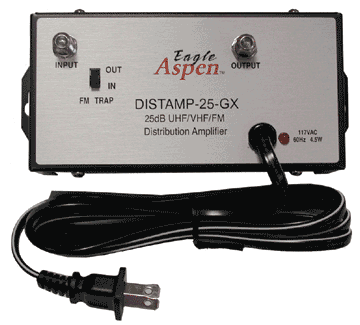More power. That’s the mission of every amplifier, whether it provides voice amplification for a stadium or line amplification for an antenna. It’s what an amplifier does. Yet, most of us are used to measuring the power of an amplifier in watts, and line amplifiers measure their power in dB (or decibels, if you’re fond of being precise.) Why is that?
All amplifiers are not created equal
An audio amplifier outputs to speakers, while a line amplifier doesn’t. A speaker is a fairly miraculous thing if you really sit down and think about it. Large magnets convert electrical energy into vibrations, and those vibrations are picked up by a thin sheet of plastic which vibrates the same way and causes a pressure wave, which is detected by your ears as sound. The truth is it takes a fairly large amount of power to make that happen. Your cell phone’s speaker isn’t very powerful, but the speakers in your home theater are; an all-encompassing sound can take 15 watts to fill your living room, or as much power as it takes for a bright CFL light bulb. Filling a stadium could take 20,000 watts, more power than your neighborhood uses.
Amplifiers for home theatre are different
On the other hand, a line amplifier such as the ones found in cell boosters, antenna amplifiers, satellite amplifiers, and the like, does not generate anything near that level of power, and it doesn’t need to. The purpose of a line amplifier isn’t to drive speakers, it’s to create a stronger signal down the line. Even the amount of power used to create sound from your cell phone could potentially overload sensitive equipment. The real key from a line amplifier isn’t volume (your perception of how loud the signal is) but fidelity (how absolutely perfect the signal is even after it’s amplified.) The wattage numbers are tiny and insignificant.
It comes down to decibels
That’s why line amplifiers show gain in dB. A decibel, as we’ve told you, is a fairly confusing little measurement that measures how much stronger something is. Many of us know decibels as a unit of sound, but that’s just one way to use this flexible measurement. Really, a decibel is a measure of change, not of sound. Using decibels for audio (dBa) you measure sound, compared to total silence. You can measure almost anything in dBs, even signals through a wire. Decibels measure the tiny amount of electricity used for signal. Measuring in dBs makes more sense than using volts or watts because of the very low level of current. When you measure signal over a wire, you’re measuring how much or how much less signal you have compared to a milliwatt. Making a signal 10 times stronger is an increase of 10dB, and making a signal 1000 times stronger is an increase of 30dB. The number of dBs, to put it simply, is an indication of the number of zeros in the amount of amplification. That makes it easy to show big changes in the strength of the signal without very quickly getting into big numbers.
Use the right terms
So, when searching for a home audio receiver, it’s still perfectly ok to think about watts, but when looking at an amplifier to help boost a cellular signal or antenna, the big number to look for is dB.





